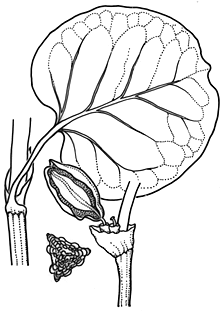Synonyms: Homalocladium APNI*

Description: Perennial shrubs or climbers, dioecious or rarely monoecious, glabrous.
Leaves petiolate or sessile, with a band of abscission tissue at base of petiole; pit nectaries present; ocrea short-tubular, brown, not ciliate on upper margin, soon disintegrating.
Flowers unisexual, in a narrow spike-like inflorescence or in subsessile clusters. Perianth segments 5, sepaloid, often enlarging and fleshy (and then readily caducous) or membranous when fruiting, not winged. Stamens usually 8 in male flowers; anthers versatile; staminodes present in female flowers. Style trifid, short; stigmas flattened, peltate, fimbriate, delicate.
Achene trigonous or globose, at least partly enclosed by the persistent perianth.
Distribution and occurrence: World: c. 19 species, Australia, New Guinea, New Zealand & South America. Australia: 11 species, all States. M. complexa and M. platyclada are often cultivated.
Text by K.L. Wilson (1990); edited KLW Wilson (Aug 2012, Dec 2012)
Taxon concept:
| | Key to the species | |
| 1 | Plants forming a more or less tangled, wiry mass, prostrate to nearly 2 m tall; leaves <1 cm long (rarely to 2 cm in M. complexa) | 6 |
| Plants with habit otherwise (shrubs,subshrubs, climbers); leaves 2–12 cm long (rarely shorter in M. diclina, which is an erect shrub) | 2 |
| 2 | Leaves c. 1–2 times as long as wide, ovate, obovate, subcircular to oblong or sagittate, with distinct petiole and base sagittate, cordate or truncate (rarely attenuate in Muehlenbeckia axillaris), persistent; plants twining, climbing, mat-forming, or decumbent subshrubs | 3 |
| Leaves 4–10 times as long as wide, linear to narrow-lanceolate (rarely hastate on young stems), sessile to subsessile with base attenuate, often not persistent on older stems; plants erect, shrubs, often intricately branched
Back to 1 | Muehlenbeckia diclina |
| 3 | Leaves with lamina sagittate, apex long-acuminate to long-acute; nut subglobose, obscurely 3-ribbed, 2.0–2.5 mm long; anthers 0.4–0.6 mm long | Muehlenbeckia gracillima |
| Leaves with lamina oblong-ovate to semicircular, the base truncate or broad-cuneate to more or less sagittate, apex obtuse to retuse and short-acuminate; nut trigonous to circular in cross-section, 2.7–5 mm long; anthers 0.6–1.7 mm long
Back to 2 | 4 |
| 4 | Stems and leaves usually strongly glaucous; erect or decumbent low shrub to 1.5 m high with stems mostly 4–15 mm diam.; anthers 1.0–1.7 mm long; leaf margins flat or somewhat undulate, usually not crisped | Muehlenbeckia rhyticarya |
| Stems and leaves not glaucous; decumbent, twining or climbing low shrubs with stems usually less than 4 mm diam.; anthers 0.6–1.0 mm long; leaf margins strongly crisped
Back to 3 | 5 |
| 5 | Nut tuberculate, subglobose, 3-ribbed near the apex with 6 additional longitudinal ridges below, 2.5–3.5 mm long; leaves ovate to oblong-ovate, often irregularly white-scabrous on the veins and margins | Muehlenbeckia costata |
| Nut smooth, ellipsoid to obovoid, with 3 longitudinal ribs, sides may be concave, 2.7–3.0 mm long; leaves semicircular to oblong-ovate, glabrous
Back to 4 | Muehlenbeckia adpressa |
| 6 | Leaves subcircular to elliptic or ovate (subpanduriform in juvenile plants); inflorescence usually axillary (rarely a few terminal on short lateral branchlets) | 7 |
| Leaves oblong to subpanduriform or narrow oblong-obovate; inflorescence usually terminal; only along the Murrumbidgee River
Back to 1 | Muehlenbeckia tuggeranong |
| 7 | More or less prostrate habit; grows at high altitude along the Great Divide | Muehlenbeckia axillaris |
| Twining, climbing, mounding habit; native on Lord Howe Island, cultivated widely elsewhere
Back to 6 | Muehlenbeckia complexa |
|


